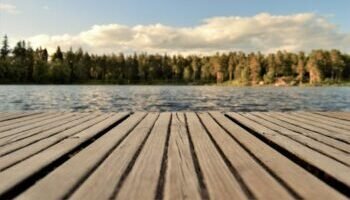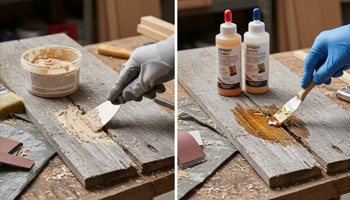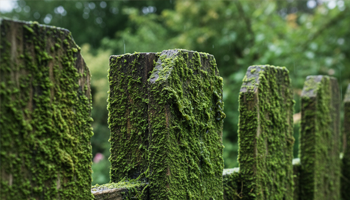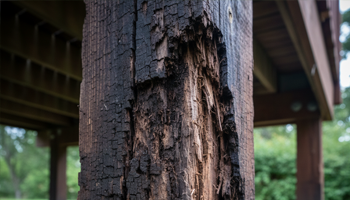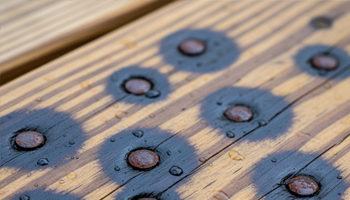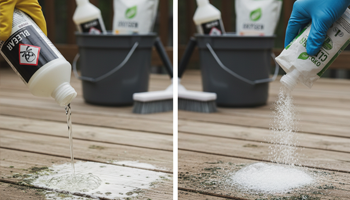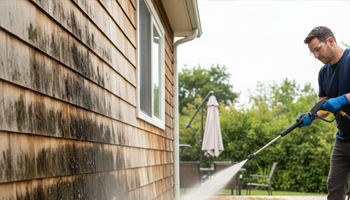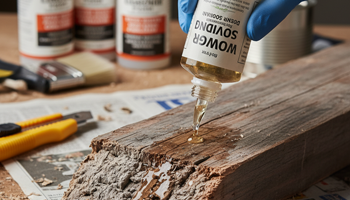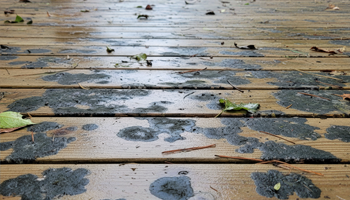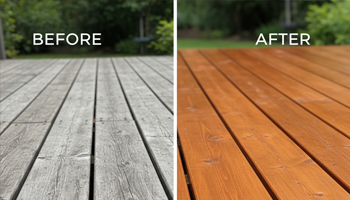Wood Restoration Problems
Make restoration decisions that fix the root cause—not just the symptom. This category organizes the most common wood failures—graying, stains, biological growth, and rot—into clear diagnosis and repair paths. You’ll find side-by-side chemistry choices (oxalic acid, oxygen bleach, sodium hypochlorite), structural repair logic (consolidate vs replace), and maintenance calendars that reduce 10-year cost.
Start Here: Diagnose Before You Treat
Confirm the problem type (UV graying vs tannin/iron stains vs mold/mildew/algae vs soft rot) and identify the moisture source that’s feeding it. Then match chemistry and repair depth to the actual failure.
Read next: Wood Restoration
Discoloration & Staining (Non-Biological)
-
UV Graying: Sun-killed lignin turns wood gray and rough. Restore color with an oxalic-based brightening step, then protect.
Read next: Greyed Wood Restoration
-
Tannin & Extractive Stains: Brown streaks, tea-colored weeping, and black drip marks—especially on cedar/redwood and near fasteners. Use the right cleaner sequence and pH neutralization to avoid fiber damage.
Read next: Remove Stains from Wood Siding & Decks
-
Nail & Screw Staining: Blue-black halos from iron-tannin reactions or galvanic corrosion; fix the chemistry and the hardware choice.
Read next: Nail & Screw Staining on Wood
Biological Growth (Mold, Mildew, Algae)
Separate true mold remediation from cosmetic mildew cleanup and algae slicks; pick chemistry by surface and risk profile.
Structural Decay & Repairs (Rot Pathways)
Decide whether to stabilize, patch, or replace—based on cross-section lost, load, and embedment.
Chemistry & Process Control
Pick the right tool for the job—and neutralize or rinse correctly to avoid finish failure later.
Prevention & 10-Year Cost
After the fix, keep water moving off the surface, break ground contact where possible, choose finishes that match your sun/shade and maintenance appetite, and calendar light-touch maintenance before failure.
Read next (overview): Wood Restoration
Material Longevity in Coastal Urban Architecture Coastal construction confronts accelerated deterioration from salt spray, humidity cycles, and UV exposure that compounds conventional weathering mechanisms. Material selection in these environments transcends aesthetic preferences or initial cost considerations—it determines whether buildings remain structurally sound and economically viable over multi-decade holding periods. The financial implications of premature material […]
Material Longevity Leer más »
Wood Filler vs Epoxy for Exterior Repairs: Weather Resistance Tested If you’re torn between “wood filler vs epoxy for exterior repairs,” here’s the blunt truth: in real weather, cheap wood filler usually buys you 18–36 months; a quality two-part epoxy, installed right, can cruise past a decade. I’ve redone hundreds of outdoor fixes because the
Wood Filler for Exterior Repairs Leer más »
Green Algae on Wood Fence Short version: Green algae on wooden fences is normal, fixable, and (with the right routine) manageable long term. Below you’ll find safe, step-by-step methods, product ratios, pro tips, and a seasonal plan to keep your fence clean without killing nearby plants. Understanding Green Algae on Wooden Fences What Is Green
Green Algae on Wood Fence Leer más »
Soft Rot in Deck Posts: Identification, Repair or Replace Decision Guide Safety First: This is a structural decision with real liability. If you’re unsure after reading this guide, replace the post or get a qualified pro to assess it. A sagging or compromised support can cause partial collapse. Understanding Soft Rot: What It Is and
Soft Rot in Deck Posts Leer más »
Nail & Screw Staining on Wood If you’re seeing blue-black halos around deck screws or rusty teardrops bleeding down siding, this guide will save you thousands. Staining from nails and screws isn’t “patina”—it’s a preventable failure that starts the day the wrong fastener touches the wrong wood in the presence of moisture. After two decades
Nail & Screw Staining on Wood Leer más »
Deck Mildew Remover: Bleach vs Oxygen Cleaners If you’re hunting for the best deck mildew remover, the internet will tell you “bleach is faster.” That’s only half the story. After restoring 1,000+ decks since the late ’90s, I’ve run enough side-by-side tests to separate myths from what actually saves your deck (and your plants). Below
Deck Mildew Remover Leer más »
How to Remove Tannin Stains from Wood Siding & Decks Short version: If you correctly diagnose whether you’re seeing true tannin bleed or an iron–tannin reaction, and you pair that with oxalic acid, proper neutralization/rinsing, and patient drying (48–72 hours, ≤15% MC) before priming, you’ll stop the stains and keep them from coming back. Below
Stains on Wood Siding & Decks Leer más »
Penetrating Epoxy vs PC Products In-Depth Review If you’re deciding between penetrating epoxies and off-the-shelf consolidants like PC-Petrifier, this guide breaks down how they work, when to use them, and how they actually perform in the field—plus the real cost per square foot when you apply enough product to do the job right. Quick take:
Wood Rot Consolidants Leer más »
Black Mold on Deck: Safe Removal & Prevention Methods Safety First: Black mold and heavy mildew release spores when you scrub. Wear proper PPE (respirator, gloves, eye protection), keep kids and pets away, and avoid mixing chemicals. If the affected area is larger than 10 sq ft or anyone at home has asthma or is
Black Mold on Deck Leer más »
Oxalic Acid vs Commercial Brighteners Compared If your deck or fence turned dull and grey, you’ve got two powerful ways to bring the color back: pure oxalic acid and commercial wood brighteners. I’ve restored hundreds of decks in the rainy, UV-intense Pacific Northwest, and here’s the blunt truth from the field: 100% oxalic acid (properly
Greyed Wood Restoration Leer más »

